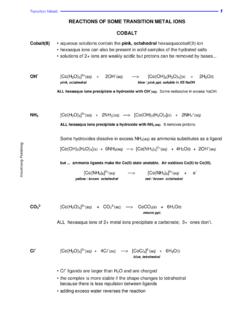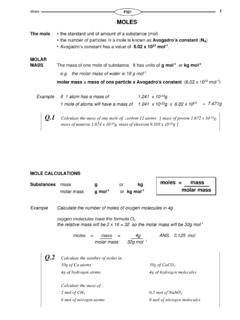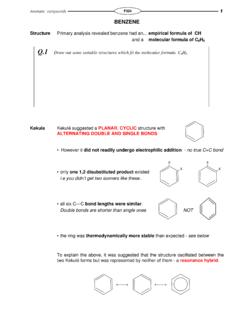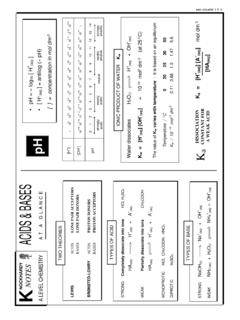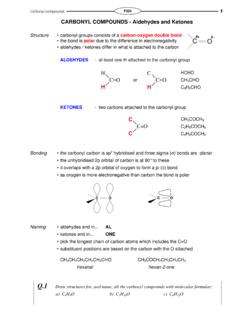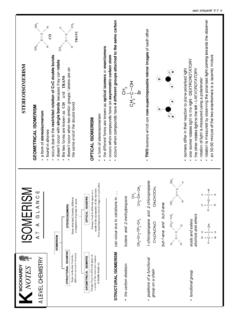Transcription of BUFFER SOLUTIONS - INTRODUCTION AND USES
1 BUFFER SOLUTIONS - INTRODUCTION AND USESD efinition SOLUTIONS which resist changes in pH whensmall quantities of acid or alkali are added. TypesAcidic BUFFER (pH < 7) weak acid + its sodium or potassium salt ethanoic acid sodium ethanoateAlkaline BUFFER (pH > 7) weak base + its chloride ammonia ammonium chlorideBiologicalUsesIn biological systems (saliva, stomach, and blood) it is essential that the pH stays constant in order for any processes to work properly. Most enzymes work best atparticular pH the pH of blood is normally about If the pH varies by it can lead to unconsciousness and coma carbon dioxide produced by respiration can increase the acidity of blood byforming H+ ions in aqueous solution CO2(aq) + H2O(aq) H+(aq) + HCO3 (aq) the presence of hydrogencarbonate ions in blood removes excess H+H+(aq) + HCO3 (aq) H2CO3(aq) (equivalent to CO2 in water)
2 Other UsesMany household and cosmetic products need to control their pH the alkalinity of the soap and prevent irritationBaby lotionMaintain a pH of about 6 to prevent bacteria multiplyingOthersWashing powderEye dropsFizzy lemonadeBuffer SOLUTIONS 1F325 KNOCKHARDY PUBLISHING 2008 BUFFER SOLUTIONS - ACTIONAcid bufferIt is essential to have a weak acid for an equilibrium to be present so that ionscan be removed and produced. The dissociation is small and there are few (aq) CH3 COO (aq) + H+(aq) relative concs. HIGH LOW LOWA strong acid can t be used as it is fully dissociated and cannot remove H+(aq) HCl(aq) > Cl (aq) + H+(aq) Adding acidAny H+ is removed by reacting with CH3 COO ions to form CH3 COOH via theequilibrium.
3 Unfortunately, the concentration of CH3 COO is small and only a fewH+ can be mopped up . A much larger concentration of CH3 COO is build up the concentration of CH3 COO ions, sodium ethanoate is alkaliAdds OH ions. Although they do not appear in the equation, they react with H+ H+(aq) + OH (aq) H2O(aq) Removal of H+ from the weak acid equilibrium means that, according to LeChatelier s Principle, more CH3 COOH will dissociate to form ions to replace thosebeing (aq) CH3 COO (aq) + H+(aq) As the added OH ions remove the H+ from the weak acid system, the equilibriummoves to the right to produce more H+ ions. Obviously, there must be a largeconcentration of undissociated acid molecules to be concentration of a BUFFER solution is also importantIf the concentration is too low, there won t be enough CH3 COOH and CH3 COO to cope with the ions an acidic BUFFER solution one needs.
4 Large [CH3 COOH(aq) ] - for dissociating into H+(aq) when alkali is addedlarge [CH3 COO (aq) ]- for removing H+(aq) as it is addedThis can t exist if only acid is present so a mixture of the acid and salt is weak acid provides the equilibrium and the large CH3 COOH(aq) sodium salt provides the large CH3 COO (aq) concentration. One uses a WEAK ACID + its SODIUM OR POTASSIUM SALT2 BUFFER solutionsF325 KNOCKHARDY PUBLISHING 2008 CALCULATING THE pH OF AN ACIDIC BUFFER SOLUTIONE xample 1 Calculate the pH of a BUFFER solution whose [HA] is mol dm-3 and [A ] mol dm-3. Assume the Ka of the weak acid HA is 2 x 10-4 mol = [H+(aq)] [A (aq)] [HA(aq)] re-arranging[H+(aq)] = [HA(aq)] Ka = x 2 x 10-4 = 2 x 10-4 mol dm-3 [A (aq)] pH = - log10 [H+(aq)] = ( )Example 2 Calculate the pH when 500cm3 of mol dm-3 of weak acid HX is mixed with500cm3 of a mol dm-3 solution of its salt NaX.
5 Ka = x 10-5 mol = [H+(aq)] [X (aq)] [HX(aq)] re-arranging[H+(aq)] = [HX(aq)] Ka [X (aq)]The SOLUTIONS have been mixed; volume is now 1 dm3 [HX] = mol dm-3 [X ] = mol dm-3 [H+(aq)] = x x 10-5= x 10-5 mol dm-3 pH = - log10 [H+(aq) ] = ( )Alkaline BUFFER Similar but is based on the equilibrium surrounding a weak base. NH3(aq) + H2O(l)(aq) OH (aq) + NH4+(aq)relative LOW LOWbut one needs ;a large conc. of OH (aq) to react with any H+(aq) addeda large conc of NH4+(aq) to react with any OH (aq) addedThere is enough NH3 to act as a source of OH but one needs to increase theconcentration of ammonium ions by adding an ammonium (a weak base) + AMMONIUM CHLORIDE (one of its salts) BUFFER SOLUTIONS 3F325 KNOCKHARDY PUBLISHING 2008
